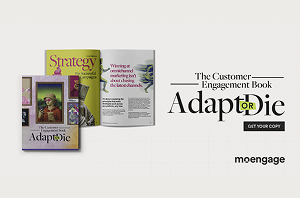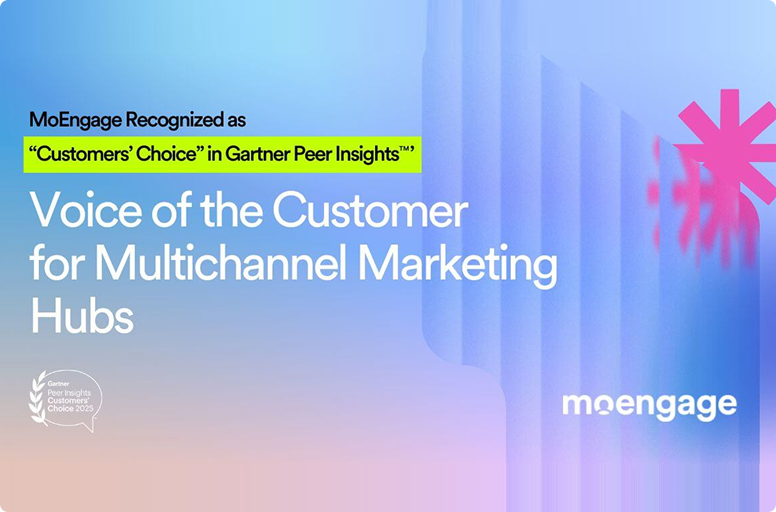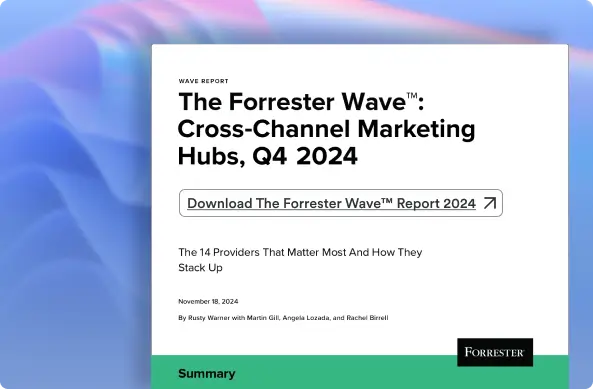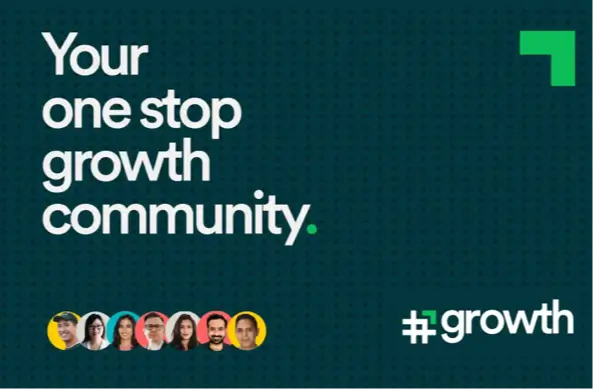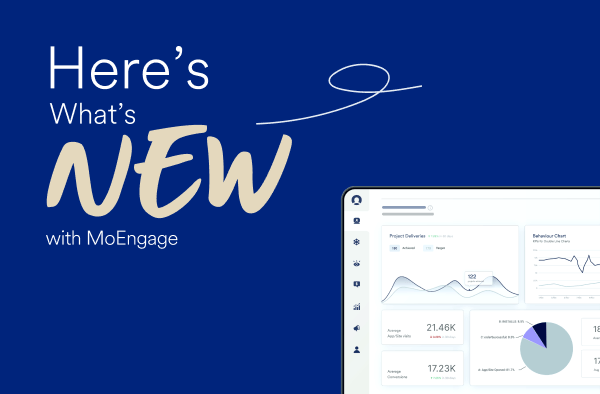Customer Engagement: Actionable Strategies for 2025 [NEW]
Master the art of customer engagement with our latest guide! Dive into strategies for personalized experiences, omnichannel success, and 1:1 engagement. Discover how a Customer Engagement Platform can transform your brand's growth. Boost revenue, build loyalty, and stay ahead in 2025!
![Customer Engagement: Actionable Strategies for 2025 [NEW]](https://www.moengage.com/wp-content/uploads/5DD7E0.png)
Reading Time: 10 minutes
Customer engagement is the cornerstone for most successful businesses today. In a world where customers connect across multiple devices and channels, quality of experience effectively takes over price as the critical difference between offerings. Hence, brands must adopt a customer-centric approach. Understanding and analyzing customer behavior is the key to providing personalized and relevant experiences, increasing conversion, retaining existing customers, and creating brand loyalists.
The journey to becoming a customer-obsessed brand is long, complex, and riddled with issues of understanding customer behavior, personalizing recommendations, dissolving silos between analytics, engagement, and automation, and enhancing cross-team collaboration. But as the saying goes, ‘A journey of a thousand miles begins with a single step.’ That single step is implementing an intelligent Customer Engagement Platform!
You’ve got to start with the customer experience and work back toward the technology, not the other way around. – Steve Jobs
What is customer engagement and the evolution of the consumer’s purchase path?
Customer engagement is a strategy to engage with customers using offline and online touchpoints such as in-store experiences, in-app experiences, social media, websites, etc.
According to a PwC survey, 73% of consumers said their experience is a critical decision-making factor while buying a product from a brand. That’s why customer engagement is no longer a good-to-have strategy. It has become a priority for brands to improve their revenue and build customer loyalty. The deeper the engagement, the more the chances for brands to increase conversions and cross-sell future products.
However, to build successful customer engagement, brands must analyze customer behavior and personalize their experience. The customer’s purchase path has significantly evolved in this connected customer experience ecosystem. Let’s look at some changes you would witness in customers’ purchase paths and some ways to adapt to them.
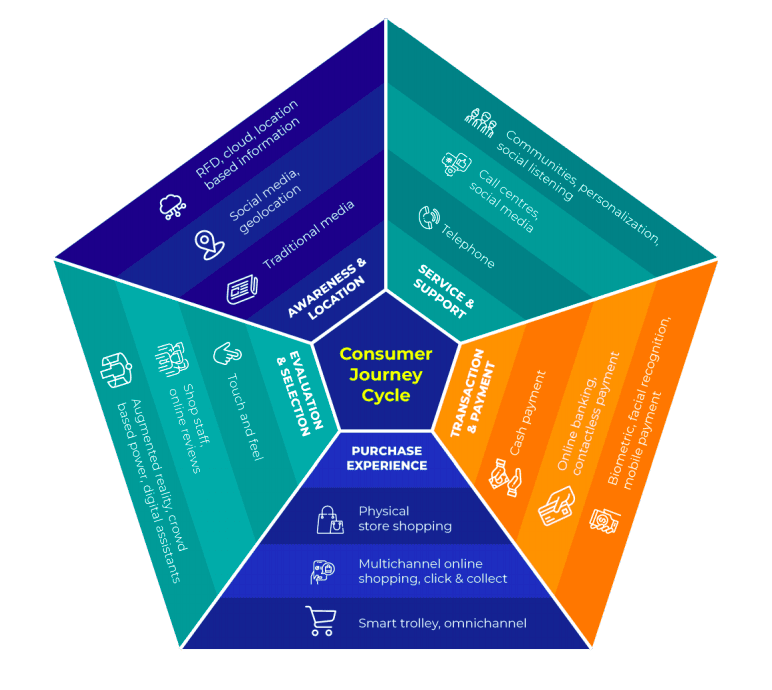
- Customers have transitioned from being passive to active buyers. They have become the sculptors of their own experience. They carefully examine the brand to ensure authenticity and deliver as promised. Before engaging, they pull information about the brand from various sources such as review websites, media chatter, etc. So, no matter how much money the brand spends, customers will buy if they are convinced about its authenticity.
- Earlier, customers would be where the brands were present. However, the dynamics have shifted. Today, brands have to be where the customers are. Customers decide how and through which channel they want to engage with the brand. This has led brands to work based on customer demands instead of supply demand.
- Customers are tired of mass marketing communication. They expect hyper-personalized marketing from brands across all channels. Hence, brands must move from the spray-and-pray method of communicating with customers toward targeted marketing.
| To know more on this topic, check out our blog on Behavioral Change and Evolution of Modern Purchase Path: Key Learning Lessons. |
How has customer engagement evolved?
As the customer purchase path evolves, brands must also consider the evolution of customer engagement. Since customers engage through multiple channels, brands must create a seamless experience. However, omnichannel engagement faces several challenges.
- The information related to the customer profile is limited to an ID or a transaction, with limited information about their preference and device type.
- There is no cohesion between the offline and online avatars of the customer. So, it’s difficult for brands to map their offline and online identity and monitor the continuous data flow between the different platforms.
- Using too many channels also leads to broken customer profiles, as brands have difficulty mapping the various profiles and creating a seamless experience.
- The lack of a complete customer profile could also lead brands to create generic campaigns that fail to engage customers effectively.
- Another challenge is that brands risk losing engagement data if the customer changes the device or platform.
The only way to address these challenges is by building a 360-degree customer view. This will help the brands create a consistent and seamless engagement with the customer.
| Read more on how to build a seamless omnichannel engagement with customers; download our e-book. |
The importance of 1:1 customer engagement
By now, it’s clear that brands can increase their revenue and take their business to the next level if they focus on customer engagement. A Deloitte survey reveals that customers will likely spend 140% more after a positive brand experience. One way to improve customer experience is through insights-driven 1:1 customer engagement. Customers do not like receiving communication that’s not relevant to their interests. 1:1 customer engagement helps brands analyze customers, predict their behavior, and communicate accordingly. This could include understanding the most active time of the customer on their platform, picking their preferred communication channel, and recommending the right content by deciphering what the customer wants to see.
Brands must also simplify the onboarding process to keep the customers engaged and nurture them throughout the journey. There will be some challenges, such as keeping every customer engaged, and multiple martech tools could lead to silos in data and impact personalization. However, companies can tackle these challenges with the help of customer engagement platforms and experimentation.
| Click to learn more on how to achieve 1:1 customer engagement. |
Customer engagement as a growth enabler for your brand
A customer engages with the brand through various channels, such as social media, emails, websites, etc. Each of these channels functions differently. This could pose a challenge for brands to provide customers with a consistent and positive experience. You can address this issue by using customer engagement platforms. A customer engagement platform is a single portal that centralizes, optimizes, and analyzes customer interactions across different touchpoints.
Apart from initiating communication with customers, a customer engagement platform can help brands analyze behavior and industry patterns and analyze the platform’s data to optimize customer engagement. It enables brands to think beyond customer acquisition and focus on retention, expansion, and cross-sell/upselling. Brands can also streamline their workflows and automate repetitive tasks, thus enabling the customer service teams to focus on long-term customer engagement and growth.
The customer engagement platform has become so crucial that the brand might have difficulty optimizing its engagement activities without it. These platforms have enabled brands to make data-backed decisions and boost engagement metrics.

How can a customer engagement platform help modern teams?
Do you know that 70% of customer experience professionals view silos as the most significant obstacle in customer service? Silos deteriorate trust between the teams and could lead to critical decision-making delays. Despite knowing the shortcomings of silos, the sales and customer service teams work in silos. They don’t collaborate, and the brand risks losing potential sales opportunities as no one takes charge. The lack of accountability and transparency could impact the brand’s sales and revenue long-term. One way to resolve this problem is by using customer engagement platforms.
A customer engagement platform consolidates all the information about the customer in a single place. This enables the sales and customer service teams to understand customer behavior, improve segmentation, and send relevant content to boost conversions. It also gives the team valuable insights into why drop-offs happen and improves engagement accordingly. It enables the teams to improve efficiency across acquisition, retention, and up-sell/cross-sell. Thus, the sales pipeline becomes manageable.
Most importantly, the teams can optimize customer engagement as the customer engagement platform automates repetitive tasks and streamlines workflows. It can help improve the team’s efficiency and boost customer engagement metrics.
| Check out our blog on customer engagement for modern teams for more information. |
Perks of customer-centricity and how a data-driven approach can help
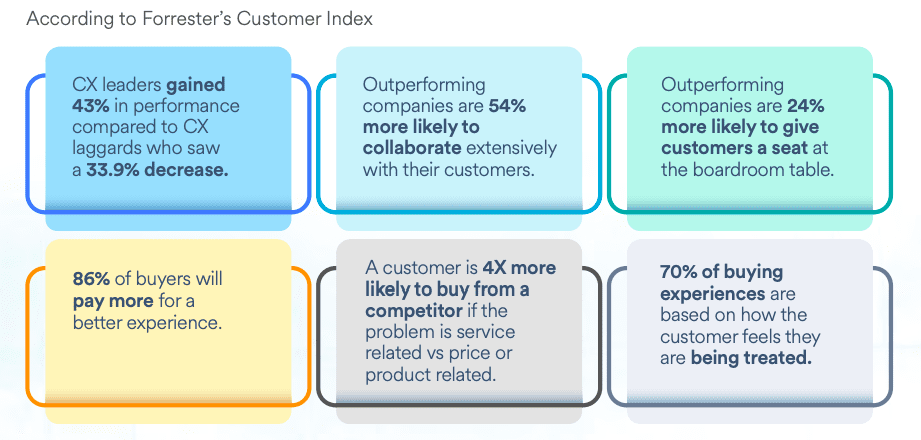
Customer-centricity is essential for building long-term customer engagement. A customer-centric approach can offer several advantages to brands.
- According to Deloitte research, a customer-centric brand is 60% more profitable than a non-customer-centric one.
- It helps the marketing team personalize the content and improve their marketing strategy for acquiring, retaining, and engaging customers.
- Customer-centricity will help the sales team gain a holistic view of the customer’s behavior and sell, cross-sell, and upsell products at the right time and boost sales.
- Customer success can predict churn in advance, proactively plug the leak, and engage with customers.
In a nutshell, being customer-centric will help brands engage with customers at various stages of the customer journey, align experiences according to the customer’s changed behavior, gain their trust, and convert them into brand advocates.
However, a brand can achieve customer-centricity only through a data-driven approach. A data-driven approach enables the brands to have better visibility of the customer across all channels. Most importantly, data is a single source of truth that everyone from sales, marketing, and customer success trust. So, brands can leverage this data to create successful customer engagement strategies. By taking a data-driven approach, brands can improve their speed of execution improve sales through better segmentation and understanding of customer behavior and engagement.
| You can read more about building data-driven customer engagement in our blog. |
11 steps to building a customer-first culture
To become customer-centric and data-driven, brands must build a customer-first culture. Everyone – from the management to employees in a customer-first environment is committed to delivering an exceptional experience. Simply put, they are customer-obsessed, which drives them to align their functions, stay agile, and promote innovation. A brand must follow these basic 11 tenets to build a customer-first culture.
- They must develop a collective focus, i.e., share a strong vision that will drive each team member to improve customer experience.
- They must cultivate an external perspective, i.e., looking at the brand from the customer’s perspective instead of focusing on internal goals.
- The brand must encourage employees to innovate. The policies must include risk as a virtue if it promises to deliver a great experience to customers and give them the autonomy to make decisions.
- They must focus on building a loyal customer base rather than on quantity. A customer-centric organization will focus more on closing a deal with a single dedicated customer than three customers likely to churn later.
- A customer-centric brand will prioritize retention and add more value to the customer’s experience by analyzing customer behavior and interacting with them. This helps in reducing the churn.
- The customer experience is driven by customer feedback captured through Net Promoter Score (NPS) qualitative and quantitative analysis.
- Customer-obsessed brands are highly data-driven. They analyze customer data for trends and common challenges and share the insights with different departments to help them make data-driven decisions.
- Customer-centric brands focus only on what the customers care most about rather than delivering unscalable wow moments all the time.
- These brands gather real-time insights about customers to provide them with exceptional experiences.
- A customer-centric brand will always hire teams demonstrating a customer-centric approach to communication and decision-making.
- A customer-centric brand will always take a ‘You’ approach instead of ‘me’ or ‘I’ in internal and external communication.

| Learn how to build a customer-first organization to create successful customer engagement. |
13 customer engagement metrics to measure
While implementing customer engagement strategies, brands must also define and measure the metrics to determine what’s working and build a better relationship with the customer. Contrary to popular belief, customer engagement metrics are not restricted to email open rates, click rates, or social media engagement. Brands could measure 13 customer engagement metrics to build meaningful customer engagement.
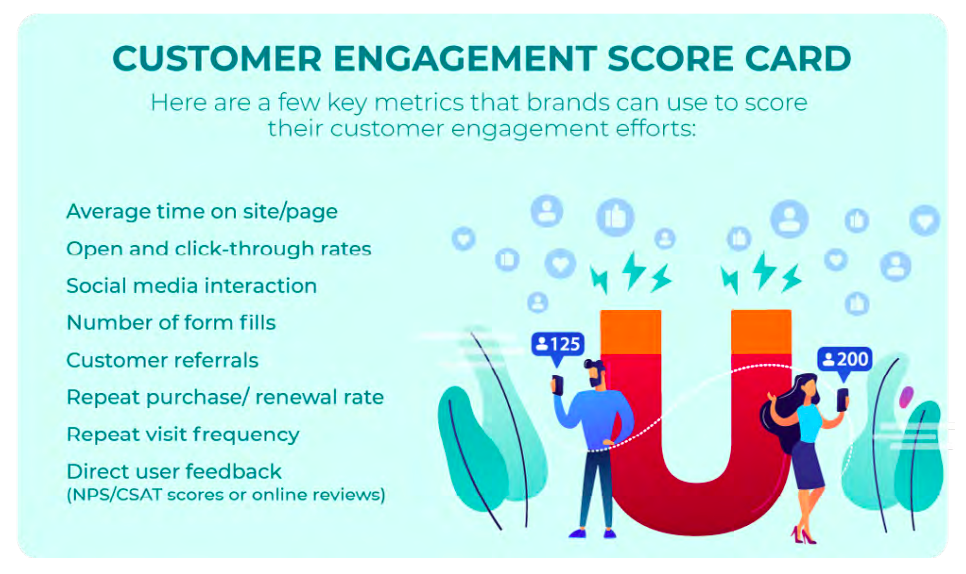
- The Net Promoter Score (NPS) measures the customers’ trust in the products/services and their consequent willingness to recommend them to others.
- The Customer Acquisition Cost (CAC) measures the cumulative index of the customer’s satisfaction.
- The churn rate measures the number of customers lost in a given period divided by the number of customers at the beginning multiplied by 100%.
- Customer Satisfaction Score (CSAT) indicates if your brand can retain customers and their probability of repurchasing products.
- Customer Effort Score (CES) indicates how much effort a customer has to put in to interact with your company.
- Customer actions: It measures customers’ activities on the website: how much time the customer spends on a particular site, clicking and viewing links.
- Activity Time indicates a customer’s time on your page after logging into your website.
- Page Visit Frequency: It measures the traffic present on your website.
- Service Accessibility Metrics measures how much service accessibility you have with your customers.
- Service Quality and VoC Metrics: It is measured based on how positive is the customer’s experience in your ecosystem and if the negative feedback is addressed.
- Staff Empowerment and Connection Metrics: It shows how your agent can cope with your customers’ moods and emotions and engages with them.
- Conversion Rate measures the percentage of customers involved in completing some actions tied to your company. These actions could include downloading e-books or clicking on Facebook ads, etc.
- Bounce Rate: The percentage of web visitors who exit your site after viewing only one page.
| Check out our blog to learn more about measuring customer engagement metrics. |
Proven methods to increase omnichannel customer engagement
As you might have already learned, customers engage with your brand through multiple channels. The boundaries between these channels have blurred, and now an omnichannel experience offers customers a unified and continuous experience. We have shortlisted 11 proven methods that can help you to improve your omnichannel customer engagement.
- Create a personalized experience.
- Offer a dynamic experience.
- Stay ahead in the game through outstanding experiences
- Make your channels work with each other
- Simplify the experience for your customers
- Understand the audience to recognize loyal customers and deliver an exceptional experience.
- Integrate in-store and online experience
- Go digital with your ad
- Create an immersive experience
- Focus on the details to build an engaging experience
- Build unique customer journeys
There is no one-size-fits-all method for building a unique omnichannel customer engagement.
However, thinking omnichannel and putting yourself into the customer’s shoes will enable you to deliver unique experiences across different channels.
| You can read about omnichannel customer engagement to gain new insights into perfecting this art. |
21 ways to rekindle mobile app engagement
A discussion on customer engagement is incomplete without mentioning mobile app engagement. You may have built a best-in-class mobile app, but all your efforts could go in vain if you don’t focus on app engagement. Mobile app engagement gives your customer reasons to return to your app and perform the desired action. This is important because research shows that an app loses 77% of its daily customers within the first three days of installation and almost 95% of them within 90 days. So, what can brands do to improve mobile app engagement? We have listed 21 ideas to rekindle customer engagement.
- Focus on customer engagement early.
- Make onboarding easy
- Distinguish between the mobile app and web experience
- Use push notifications smartly (preferably send event-based notifications)
- Keep the messages natural and actionable
- Communicate and be interactive
- Focus on digital responsiveness
- Leverage the right channels
- Implement widgets
- Incorporate chatbots
- Provide location-based app ideas
- Add spotlight indexing
- Employ analytics
- Re-engage your mobile app customers
- Re-look and optimize the onboarding process
- Deeplink to the relevant in-app location
- Employ intelligent in-app analytics and insights
- Offer rewards
- Make social sharing easy
- Increase app utility
- Develop a seamless cross-channel experience
| For more ideas on improving mobile customer engagement, read this article that discusses ways to improve mobile app engagement. |

